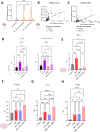EphB2-mediated ephrin-B reverse signaling on microglia drives an anti-viral, but inflammatory and neurotoxic response associated with HIV
- PMID: 40588746
- PMCID: PMC12211399
- DOI: 10.1186/s12974-025-03481-9
EphB2-mediated ephrin-B reverse signaling on microglia drives an anti-viral, but inflammatory and neurotoxic response associated with HIV
Abstract
Background: Pathological inflammation with a loss of synaptic integrity and function has been implicated in HIV Associated Neurocognitive Disorders (HAND). Although therapeutics exist to increase the lifespan of people living with HIV (PLWH), they are not effective at preventing neuroinflammation and HIV induced neuronal damage persists. In this study, we investigate the ephrin-B/EphB axis, which regulates inflammation, in post-mortem brain specimen of PLWH and experimental models in order to assess its potential role in HIV induced neuroinflammation.
Methods: We analyze mRNA samples of post-mortem brain specimen of PLWH and uninfected controls obtained from the National NeuroAIDS Tissue Consortium (NNTC) and, for comparison, of a transgenic mouse model of neuroHIV using quantitative reverse transcription polymerase chain reaction (qRT-PCR). Follow-up experiments employ mouse brain tissue and in vitro models, including immortalized human microglia, human induced pluripotent stem cell (iPSC)-derived mixed neuroglial cell cultures, cellular and molecular interference, functional and multiplex assays, immunofluorescence and mRNA sequencing to examine the role of the ephrin-B/EphB axis in neuroinflammation and the associated neurotoxicity.
Results: Using qRT-PCR we find increased expression of EphB2 in post-mortem brain of PLWH, and detect a correlation with pro-viral DNA, viral RNA and an inverse correlation with abstract executive function and verbal fluency. Increased expression of ephrin-B/EphB at mRNA and protein level is also observed in brains of a transgenic mouse model of neuroHIV suggesting the upregulation can be driven, at least in part, by expression of viral gp120 envelope protein and a type I interferon, IFNβ. Additionally, we find induction of ephrin-B1 expression in microglia following activation by IFNβ. Given the previously reported impact of EphB2 on inflammation in the periphery, the functional role of EphB2-mediated ephrin-B reverse signaling on microglia is assessed for a pro-inflammatory and anti-viral signature. We find that EphB2 treated microglia secrete inflammatory and anti-viral factors but also exert contact-independent neurotoxicity. Finally, knockdown of microglial ephrin-B1, an EphB2 binding partner, shows a partial alleviation of the microglial pro-inflammatory signature and neurotoxicity.
Conclusion: Our study suggests that elevated EphB2, and its reverse signaling through ephrin-B1 in microglia contribute to neuroinflammation and neurotoxicity in neuroHIV.
Keywords: EphB; Ephrin-B; HIV-1; Interferon-β; Microglia; Neuroinflammation; Neurotoxicity.
© 2025. The Author(s).
Conflict of interest statement
Declarations. Ethics approval and consent to participate: The NNTC studies were conducted in accordance with human subject protection protocols with written consent obtained at the collection sites. Participants were enrolled at any of 4 NNTC clinical sites located in Galveston TX, Los Angeles CA, New York City NY, and San Diego CA. Enrollment and collection of specimens was performed under the oversight of each medical center’s local Institutional Review Board. All participants consented to the use of their data for the purposes of HIV and neuroAIDS/neuroHIV research with all informed consent procedures including tests of comprehension to ensure cognitively impaired participants were able to consent. Criteria for enrollment of individuals in the study includes willingness to be an organ donor upon demise. The following offices maintained the IRBs that performed oversight for the protection of human subjects: University of Texas Medical Branch Office of Research Subject Protections, Galveston, TX; University of California, San Diego, Human Research Protections Program, San Diego, CA; University of California, Los Angeles, Office of Human Research Protection Program, Los Angeles, CA; Mount Sinai Medical Center, Program for Protection of Human Subjects, New York, NY. All procedures involving animals were performed in accordance with the National Institute of Health Guide for the Care and Use of Laboratory Animals and approved by the Institutional Animal Care and Use Committees of the Sanford-Burnham-Prebys Medical Discovery Institute, The Scripps Research Institute and the University of California, Riverside. Consent for publication: N/A. Competing interests: The authors declare no competing interests.
Figures






Update of
-
EphB2-mediated ephrin-B reverse signaling on microglia drives an anti-viral, but inflammatory and neurotoxic response associated with HIV.Res Sq [Preprint]. 2025 Apr 1:rs.3.rs-5523243. doi: 10.21203/rs.3.rs-5523243/v1. Res Sq. 2025. Update in: J Neuroinflammation. 2025 Jun 30;22(1):171. doi: 10.1186/s12974-025-03481-9. PMID: 40235485 Free PMC article. Updated. Preprint.
References
-
- Kaul M, Garden GA, Lipton SA. Pathways to neuronal injury and apoptosis in HIV-associated dementia. Nature. 2001;410:988–94. - PubMed
MeSH terms
Substances
Grants and funding
LinkOut - more resources
Full Text Sources
Medical
Miscellaneous

